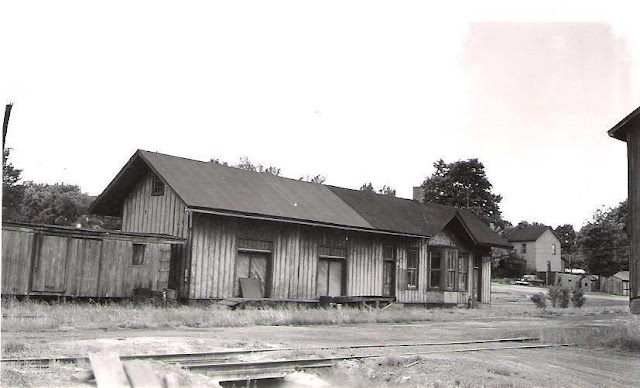 |
No. 1 of the Prattsburg Railroad, fondly known as "Old Huldey."
By Richard F. Palmer
|
One of the many picturesque little short-lines that once connected the small communities of central New York with the outside world was the Prattsburg Railroad, nicknamed the "Kick & Push." Originally known as the Kanona & Prattsburg, this 11.4 mile line existed between 1889 and 1961.
Like most shortlines, this one had a personality all its own. But it is not within the scope of this article to recount its complete history, which is more than adequately covered in the book "Keuka Lake Memories" by the late William R. Gordon of Rochester.
The first part of this article deals with the railroad's first steam locomotive, Number 1, which was used from the day it was delivered at Kanona until it finally wore out and was junked in 1939. A machine that can last for 50 years in itself is a record in today's "throw-away" economy.
Affectionately known as "Old Huldey," this locomotive, of the "4-4-0" wheel arrangement, was built by the Pittsburgh Locomotive Works in January, 1889, as serial number 871. To the more mechanically-minded, this locomotive had 62-inch drive wheels and cylinders of 17-inch bore and 24-inch stroke. "Old Huldey" was a pioneer and was there from the beginning. She powered the work trains that built the railroad, then spent the rest or her days hauling passengers and freight.
In her waning years, "Old Huldey" became a temperamental old machine and it took a lot of coaxing, along with chewing gum and baling wire, to keep her going far beyond her years. In her last years, she became known as the "Matriarch of Mileage." What follows are excerpts from an interesting article about this old engine, as well as the story of the railroad itself, that appeared in the Rochester Democrat and Chronicle Sunday Magazine on Nov. 5, 1939:
Old Huldey, a locomotive on the Prattsburg-Kanona Railroad, has covered no less than a million miles in 50 years, and all on a track 11.44miles long.
Huldey is thought to be one of the oldest engines...possibly the oldest...in the country in point of age and continuous service. Since the line was opened in September, 1889, there has never been a crossing accident. There has been the occasional derailment, but never a wreck. Small wonder the farmers and businessmen who own the railroad are proud of its record!
The Kanona & Prattsburg Railway Company was organized in 1888 through the efforts of a large group of men, some of whom contributed as much as $3000.
Others donated time and material, and great was the local rejoicing in September, 1889, when sufficient track had been laid to permit the transportation of Steuben County folks as far as the cut a mile south of Prattsburg where they were met by rigs and taken on into Prattsburg to attend the annual fair.
A month later, 50 years ago this month, the line was completed...
In 1917, beset by financial difficulties the Kanona & Prattsburg Railway Company was sold at foreclosure, but 171 of its loyal friends came to the rescue with the necessary funds and the road was reorganized as the Prattsburg Railway Corporation.
In 1932 the little railroad achieved momentary fame when it paid the largest dividend to stockholders of any road in the country.
Its equipment includes two engines, the 11.44 miles of track and .76 miles of siding, a station and six warehouses in Prattsburg and the use of the Erie station at the Kanona terminal, and a turntable at Prattsburg.
Because the upgrade is toward Prattsburg, an approximate 258-foot rise, the engine is backed down and comes home head first....It is not an uncommon sight today to see the train cut in half at the grade and pulled in in sections if the load is over the usual four to six cars.
It might also be noted that due its many financial trials and tribulations, the Prattsburgh Railroad is said to have had more "receivers" than the local telephone company. Nevertheless, the little railroad served its purpose well. There were only three regular stations on the line, at Kanona, Wheeler and Prattsburg. The flag stations or crossroads were Bean's Station, Stickney's, Dinehart's, Marshall's and Jordan's. Passenger service was discontinued in 1929. The railroad was immortalized in this rhyme written in 1909 by Irv Nichols of Cortland, a traveling salesman, and published in his little book. Rhymes of the Road.









